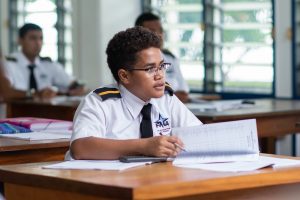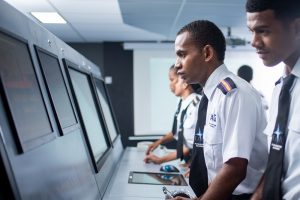

Fiji Maritime Academy student during a class.
Fijian Seafaring History
Ever since people of Lapita culture of the prehistoric Austronesians paddled their canoes across the Pacific and settled in our land, Fijians have had a passionate attachment to the sea. The seafaring culture was truly embedded in islanders when navigators like James Cook visited Lau Islands in 1774 and the arrival of vessel Leonidas on 15th May 1879 with indentured labourers from India. An archipelago consisting of some 330 islands and 540 islets, it’s estimated that about 100 islands are inhabited in the Republic of Fiji.
Current Seafarers of Fiji
While people frequently travel between the three main islands onboard local ferries, others take to the sea in fibreglass boats. The tourist industry in Fiji operates a variety of motor vessels. There also several sailing boats plying around Fiji waters. Fiji also has a fleet of fishing boats manned by locals and foreigners.
Each of these vessels needs a minimum crew as safe manning regulation. There are also shore-based workers to support operations, making up the large employed in the shipping sector. One is not wrong to call Fiji a seafaring nation.
 Training and Education
Training and Education
Recognising that the shipping industry is an essential service, the Fijian Government allocates generous grants and considerable capital expenditure from its budget through Fiji National University (FNU) to programmes conducted by Fiji Maritime Academy (FMA) for seafarer training and education.
Without competent and qualified seafarers, Fijians will not be able to travel to the islands or transport goods and the tourism industry will grind to a halt.
The University and the Academy ensure that the workforce demands are met. The backbone of this competency-based training is the Diploma programmes, rating and short courses that are conducted throughout the year.
Employment
Apart from the demand from local ships, the international shipping industry requires qualified seafarers.
There are an estimated 1.5 million officers, rating and catering staff on board international ships. In these days of the COVID-19 pandemic with little or no air transport, seaports are all working 24/7 with ships carrying the bulk of the essential goods. Since 2014, FMA has placed more than 30 cadets on foreign-going ships. More than 100 Fijians are working on Swire Shipping vessels in various capacities. Their count is more than three times on other shipping companies which is unrecorded.
Each of these Fijians brings to the country a much-needed foreign remittance, with 50% of the cadet’s pay transferred directly to their accounts in Fiji. Fijians are a popular choice as crew on foreign vessels. They are strong and hard-working. Fijians are used to living in isolated communities, which depicts a typical ship life.
The embedded seafaring culture helps them to survive the turbulent sea life.
While the current world shipping fleet employs crew are from non-English speaking background, Fijian have a distinct advantage in communication skills as the working language on a ship is English.
Future seaters
Currently, FMA conducts programmes up to the Class 3 level. In 2022 some experienced seafarers will be able to qualify for Class 1 and 2 Management level programs. Fiji will have more senior officers and even more joining foreign ships, paving way for new school-leavers to join the industry.
In addition to four female cadets for the first time to the Swire shipping training program, Fiji should expect a female Captain or a Chief Engineer in a foreign vessel in the future.
Training and education will also change to make way for green shipping to mitigate climate change. Propulsion of a vessel across the oceans began with paddling, sails, steam, and the current practice of the use of fossil fuels in diesel engines. It seems now we need to go back to basics. The use of sails and solar may be alternatives to reduce the emissions from fuels causing harm to the environment.
To eliminate the use of fossil fuels, ships’ propulsion will be redesigned to use either hybrid wind or gas for bigger ships or solar for smaller boats. That means new skills in sailing and technology will be introduced to the curriculum. As long as 75% of the earth is covered by oceans the noble profession of seafaring will continue to the future as it is impossible to ascertain any other mode of transport to move 23,000 containers such as the HMM Algeciras. Seafarers will have a rewarding career in the future and the training will continue for many decades or even centuries.
Mahesa Abeynayake
Chief Executive Officer and Director in Charge
Fiji Maritime Academy